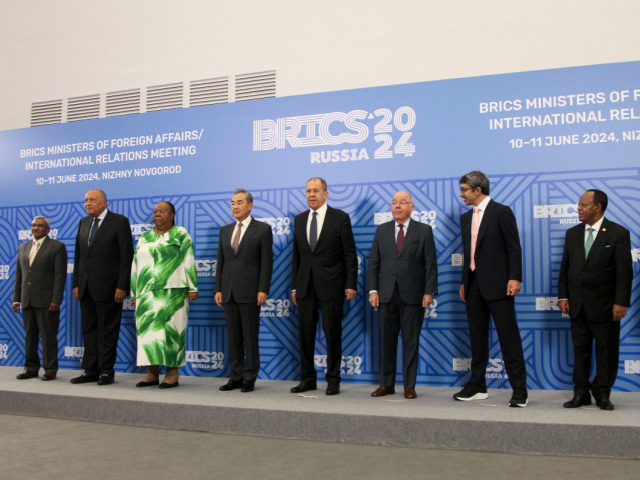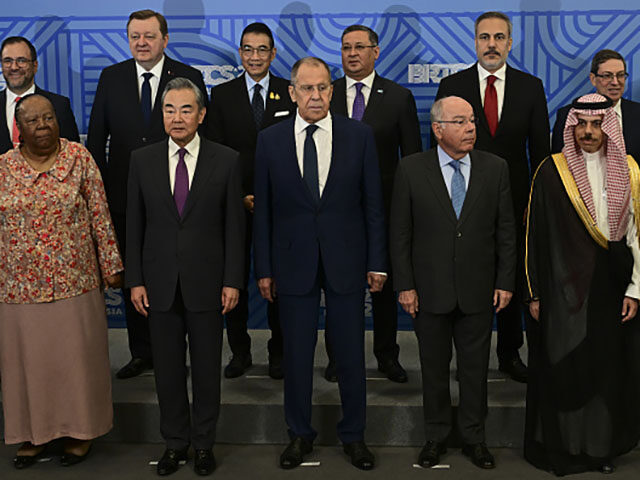A recently published study found that the five core members of the BRICS anti-Western bloc emitted more carbon dioxide from power generation than the entire world combined during the first quarter of 2024, Reuters reported on Wednesday.
BRICS – named after members Brazil, Russia, India, China, and South Africa – is a security and economic organization bringing together self-proclaimed members of the “developing world” for the purpose of shielding each other from human rights sanctions and strengthening each other’s influence on the world stage. The clique welcomed four new members in January – Iran, Ethiopia, Egypt, and the United Arab Emirates (UAE) – and has been awaiting the completion of Saudi Arabia’s membership requirements as of February.
WATCH — Elderly Climate Activists Attempt to Damage Magna Carta:
Video Source: Just Stop Oil via StoryfulBRICS held a meeting of its foreign ministers this week in Nizhny Novgorod, Russia, to prepare for the annual meeting of its heads of state in October. Reports indicated that much of the meeting focused on making members less dependent on the U.S. dollar for international trade, limiting the effect of Western human rights sanctions.
The joint statement participating nations published following their meeting heavily emphasized the organization’s concerns about climate change, but rather than including commitments by BRICS states to reduce pollution, the countries demanded that “developed” nation increase their financial contributions to “developing” nations to “transition” away from fossil fuels.
Following the expansion in January, BRICS controls 43 percent of the world’s crude oil production (assuming Saudi Arabia finalized its membership), more than the Organization of Petroleum Exporting Countries (OPEC). BRICS nations are also outstanding producers of natural gas, coal, and other fossil fuels – in addition to including the world’s most prolific greenhouse gas emitter, China, and major emitters India, Russia, Brazil, and Iran.

From left, India’s BRICS Sherpa Dammu Ravi, Egypt’s Foreign Ministers Sameh Shoukry, South Africa’s Foreign Ministers Naledi Pandor, China’s Foreign Minister Wang Yi, Russian Foreign Minister Sergey Lavrov, Brazil’s Foregn Minister Mauro Vieira, UAE Foreign Minister Sheikh Abdullah bin Zayed Al Nahyan, Ethiopia’s Foreign Minister Taye Atske Selassie and Iranian Acting Foreign Minister Ali Bagheri Kani pose for a photo on the sidelines of the meeting of BRICS foreign ministers in Nizhny Novgorod, Russia, Monday, June 10, 2024. (Roman Yarovitsin/AP)
According to the energy think tank Ember, BRICS “emitted a record 1.98 billion metric tons of carbon dioxide from power generation during the first quarter of 2024,” Reuters’ Gavin Maguire highlighted in a column on Wednesday. Over 90 percent of these emissions were from China and India, the world’s two most populous states.
“That emissions toll was roughly 500 million tons greater than the entire emissions load generated by the rest of the world combined,” he noted, “and highlights the diverging pollution trends between key fast-growing economies and most developed countries.”
China is the world’s largest greenhouse gas emitter and, while signing onto international climate agreements for years, often carves out exceptions to allow itself to continue polluting while still being considered to be abiding by the deal. China joined the famed 2015 Paris Agreement on climate, for example, but committed only to “peak” in carbon emissions – meaning increase emissions over time before hypothetically beginning to decline – as a “goal” by 2030. At the COP26 climate conference in 2021, China issued another “pledge” to continue to increase carbon emissions.
“The country discharged roughly 5.4 billion tons of CO2 from fossil fuel power generation in 2023, or roughly 40% of the global total, which has made China a key target for international pressure to reduce global pollution,” Maguire noted on Wednesday.
The Reuters analysis expressed concern that BRICS’s growing geopolitical leverage could grant its members “the means to largely ignore western economic pressure to reduce pollution.”
WATCH — CNN’s Weir: New Biden Coal Rules ‘The End of Coal as a Power Source’:
The BRICS countries certainly deflected pressure on reducing pollution away from themselves in the joint statement following the foreign minister meeting on Tuesday, focusing instead of “equity and common but differentiated responsibilities” to fight alleged climate change.
The over 5,000-word joint statement featured multiple provisions on climate change, proclaiming support for United Nations efforts, including the annual Conference of the Parties (COP) meetings, but condemnations for specific measures on climate that would require BRICS nations to make changes to their policies.
“The Ministers expressed opposition to the imposition of any restrictive measures in global trade as a pretext for combatting the climate change,” the statement read, for example. Elsewhere, the BRICS countries “condemned unilateral, punitive and discriminatory protectionist measures, that are not in line with international law, under the pretext of environmental concerns.”
WATCH — ABC’s Hostin Links Eclipses, Earthquakes, Cicadas to Climate Change:
Among them were “due diligence requirements” for companies and “carbon border adjustment mechanisms (CBAMs).” CBAMs are taxes imposed on imports based on how many greenhouse gases were emitted during their production, essentially punishing countries for polluting in the manufacturing process.
The BRICS statement repeatedly called for the redistribution of money and technology from “developed” states to “developing” states, which China insists that it is despite being the second-largest economy on earth.
“They [the BRICS foreign ministers] emphasized the need for developed countries to enhance transfer of low-cost climate technology in an affordable and accessible manner,” the statement read, “capacity building along with affordable, adequate, predictable and timely new additional financial resources as critical enablers of climate action in developing countries.”
In a separate demand for more money, the statement continued, “it is important that the UN agencies, MDBs and other international agencies also support the climate actions of the developing countries with additional and concessional climate finances.”

COMMENTS
Please let us know if you're having issues with commenting.